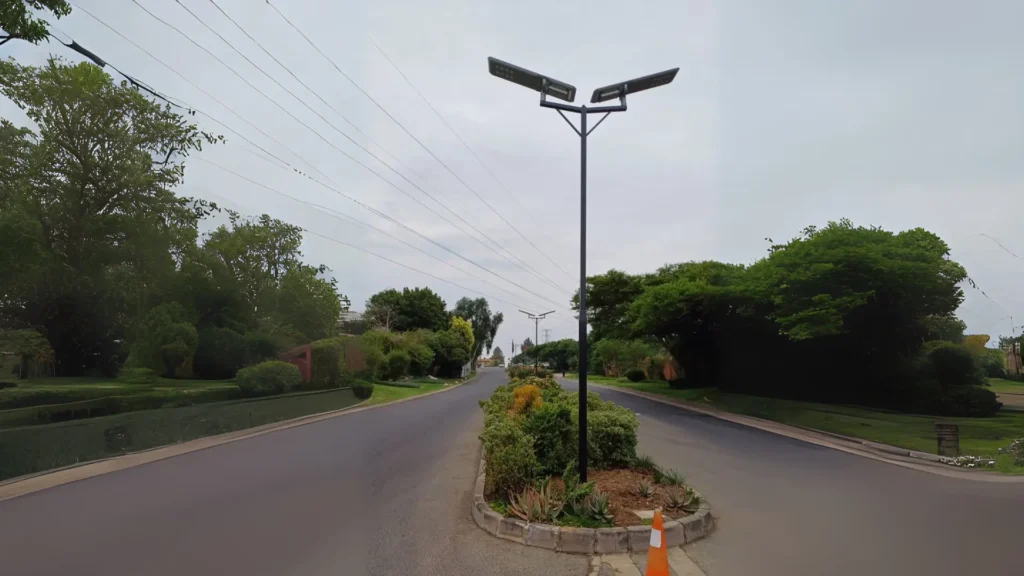As global attention on renewable energy and sustainable development continues to grow, South Africa, a key economic hub in Africa, is actively promoting the green transformation of its infrastructure. This project successfully improved nighttime lighting conditions on select roads and public areas in South Africa by introducing Sresky Atlas solar streetlights—enhancing public safety while significantly reducing energy consumption and operational costs.
1. Project Background and Needs Analysis
1.1 Project Background
As a leading player in Africa’s economy, South Africa has consistently invested in infrastructure development, particularly in initiatives that enhance public safety and quality of life. This project aimed to improve lighting conditions on specific roads and in public spaces using advanced solar lighting solutions. The goal: ensure safety for pedestrians and vehicles at night, reduce dependence on traditional energy sources, and respond to the global push for sustainability and energy efficiency.
With over 2,500 hours of sunshine annually, South Africa has a natural advantage for solar energy deployment. However, certain regions lack sufficient grid coverage or face high maintenance costs for conventional lighting, resulting in inadequate nighttime infrastructure and compromised public safety. An efficient, autonomous lighting system was urgently needed to address these gaps and promote green development.
1.2 Needs Analysis
-
Lighting Requirements: The project area lacked adequate nighttime illumination, necessitating a high-brightness, stable lighting solution to ensure safety for both pedestrians and vehicles.
-
Energy Sustainability: Capitalizing on South Africa’s strong solar resources and favorable renewable energy policies, solar lighting was chosen to lower the carbon footprint and reduce electricity expenses.
-
Weather Resilience: Certain areas experience long rainy seasons, requiring a lighting system that functions reliably during extended periods of overcast or rainy weather.
-
Maintenance Cost Considerations: Traditional lighting systems incur high maintenance costs. A low-maintenance, long-lasting solution was essential.
-
Environmental Aesthetics: As public infrastructure, the lighting system needed a sleek, modern design that complements the urban landscape and improves overall visual appeal.
2. Technical Solution Design
2.1 Core Technology Selection: Sresky Atlas Solar Streetlight
This project adopted the Sresky Atlas solar streetlight, whose cutting-edge features aligned perfectly with the project’s objectives:
-
ALS2.4 Adaptive Lighting System
This system intelligently adjusts brightness based on battery levels, guaranteeing over 10 days of lighting even during prolonged cloudy or rainy conditions. It overcomes the limitations of conventional solar lights by ensuring 100% year-round illumination. -
BMS Battery Management System
BMS technology boosts battery charging efficiency by over 30%, making full use of sunlight and extending battery life—particularly useful in South Africa’s variable weather patterns. -
TCS Temperature Control System
Ensures battery stability across a wide range of temperatures (Charging: 0°C to +45°C; Discharging: -20°C to 60°C), enhancing reliability through seasonal changes. -
High-Efficiency Components:
-
Solar Panels: Monocrystalline silicon with charging efficiency >21%, maximizing energy conversion.
-
LED Chips: OSRAM 3030 LEDs with luminous efficacy up to 230 lm/W, delivering bright yet energy-efficient lighting.
-
Lithium-ion Batteries: With 2,000 cycles, these batteries—based on EV technology—offer long-lasting performance.
-
-
Smart Control Mode:
-
PIR Sensor: 120° wide-angle, 8-meter detection range, adjusting brightness based on motion detection.
-
Multiple Lighting Modes:
-
M1: 30% brightness (PIR sensing) until dawn
-
M2: 100% brightness for 5 hrs + 25% brightness for 5 hrs (PIR) + 70% brightness until dawn
-
M3: 70% brightness until dawn
-
These flexible settings suit diverse application scenarios.
-
-
-
Structural Design:
-
IP65/IK08 Rating: Waterproof, dustproof, and impact-resistant—ideal for outdoor deployment.
-
Materials: Aluminum and PC construction with dual anti-corrosion layers for extended service life.
-
Easy Maintenance: Modular components can be replaced directly on the pole, minimizing maintenance costs.
-
3. Project Implementation and Deployment Process
3.1 Precise Planning and Customized Layout
-
Recommended Configuration: Atlas luminaires installed at 4 meters height, spaced 15 meters apart, ensuring consistent illumination and optimal coverage.
-
Intelligent Layout: Strategically placed in high-traffic areas, blind spots, and intersections, using a hybrid mode (constant + motion sensing).
-
Scalable Design: Provision for future battery and module upgrades ensures long-term flexibility.
3.2 Rapid Deployment and Localized Construction Guidance
Installation followed Sresky‘s international standard operating procedures, adapted to local conditions:
-
Foundation Construction: Standard C20 concrete foundation enhances wind and seismic resistance.
-
Assembly: Components pre-checked and packaged at the factory; on-site assembly is efficient and simple.
-
Installation Completion: Poles are erected manually or by machine, aligned with foundations, and securely fixed.
4. Project Outcomes and Impact
4.1 Enhanced Public Safety and Convenience
With 6,000 LM of high-brightness output, the Atlas lights greatly improve visibility, lowering the risk of traffic accidents and crime. Residents benefit from a safer environment for nighttime activities.
4.2 Energy Efficiency, Environmental Protection, and Sustainability
Powered entirely by solar energy, the system incurs zero electricity cost and reduces annual carbon emissions by several tons—contributing to South Africa’s sustainability goals. The ALS2.4 system guarantees reliable operation during extended rainy periods.
4.3 Reduced Operational and Maintenance Costs
Fully self-sufficient, the lighting system requires no grid connection. Its modular design simplifies maintenance, and the long-lifespan batteries (1,500+ cycles) reduce replacement frequency, significantly lowering total ownership costs.
4.4 Enhanced Urban Image and Resident Satisfaction
The modern, sleek design of the Sresky Atlas adds aesthetic value to the urban landscape. Community feedback has been overwhelmingly positive, with residents appreciating the improved safety and ambiance.
Summary
The South Africa road and public space solar streetlight project highlights the superior performance of the Sresky Atlas in lighting efficiency, energy savings, and adaptability to environmental conditions. Beyond improving safety and quality of life, this project offers a scalable, sustainable model for solar lighting deployment in emerging and developed markets worldwide.
Table of Contents
